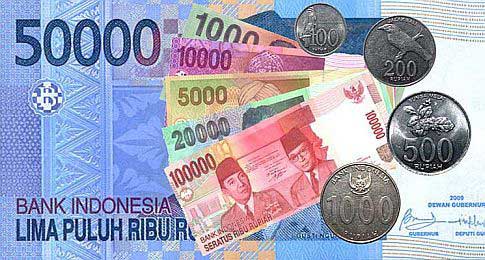Indonesians also use the informal name “perak” (“silver” in Indonesian) for the rupiah. The rupee is made up of 100 sen, although due to inflation, all notes and coins denominated in seen have completely disappeared.
In circulation there are paper banknotes worth 1000, 2000, 5000, 10,000, 20,000, 50,000 and 100,000 and coins with a face value of 10, 25, 50, 100, 200, 300, 500 and 1000 rupees. Beginning in 1993, Indonesian banks began issuing 50,000 and 100,000 polymer banknotes.
It was believed that polymer banknotes would be stronger than paper ones and much less prone to counterfeiting. However, in 2004, banks returned to issuing regular paper notes, as electronic calculators were having problems counting polymer money.
The exchange rate of the rupee against the dollar is constantly changing, at the end of October 2010 it was 8900 rupees per 1 US dollar. Indonesia has a very high inflation rate, so don’t be surprised if you find big differences in the exchange rate in different places.
In large cities, hotels, shops and restaurants accept plastic cards for payment. In the tourist places of Bali, you can pay with dollars. But when visiting places that are not popular with tourists, it is simply necessary to have a sufficient amount of rupees with you. Interestingly, some tribes in Indonesia still use barter. Indonesians are often careless with their banknotes, for example, in banks they are simply pierced with a stapler.
You can exchange foreign currency for local at the airport, at banks, at hotels, at specialized exchange offices. The most favorable exchange rate is of course in banks. Be careful when exchanging money in street exchangers, tourists are often deceived in them.
History of the Indonesian rupiah
From the beginning of the 17th century, the Dutch East India Company launched a monetary system (designated “VOC”, “Dutch East India Company”) in what later became the Netherlands East Indies. In 1800, the company went bankrupt and control of the territory passed to the Netherlands. In 1802, on behalf of the then Dutch government of the Batavia Republic.
the first coins were minted – low-value copper duets, as well as silver and gold guilders. The guilder supplanted various local currencies common in the East Indies.
including the Sumatran dollar, which disappeared in 1824, and the Javanese rupee, minted by the Dutch, in 1816. Some other kingdoms and sultanates, before they came under Dutch influence, had own coins are in circulation, such as, for example, the keeping of the Ache Sultanate (Ache was finally conquered in 1903).
The low-value coins turned out to be a currency that, by modern Indonesian standards, could be considered very stable and be a financial instrument for making daily payments.
In 1828, the central bank “De Javas Che Bank” (Javanese Bank) was founded, which in the same year began issuing banknotes. Basically, banknotes were issued with a face value of 5 guilders and more, smaller calculations could be easily made using coins.
Although the roles of the government (issuing coins) and the issuing bank (issuing banknotes of 5 guilders and above) were fairly well established, in 1919 the government began issuing 1 and 2½ guilder notes to conserve the metal, largely driven by the First world war. In 1920, ½ guilder notes were issued.
After the outbreak of World War II, guilders were collected, and the government again issued 1 and 2½ guilders in 1941 to make up for the shortfall (partly caused by supply problems with coins that were minted in the US).
1942 – 1945 Japanese occupation – start of hyperinflation in Indonesia
In 1942, the Japanese occupied Indonesia, liquidated banks, including “De Javas Che Bank”, and declared IOUs invalid. Along with this.
it was announced that the banknotes issued by “De Japanese Revering” (Japanese government) would become legal tender from March 1942 (although the existing banknotes remained valid), along with banknotes from 1 cent to 10 guilders printed by the new Nampo Kaihatsu Gingko Bank.
At the same time, Dutch banknotes were printed in the United States for use until the end of the war. These banknotes, issued in December 1942 and dated March 1943 on the banknotes themselves.
had the notation “Nederlandsch-Indische Gouvernementsgulden” printed in Dutch along with additional Indonesian text reflecting the denomination of the banknote and containing the word “roepiah”. As you know, the war dragged on longer than expected and this money was not released on time.
Continuing their occupation, by 1944 the Japanese had identified their long-term strategic interests, which could best be promoted by encouraging Indonesian nationalism. New banknotes were issued, printed in Indonesian, the “Rupee of the Netherlands East Indies”.
By the end of the war, due to the actions of the Japanese, there was a massive increase in the money supply – from 230 million guilders in pre-war banknotes to several billion in post-war ones. Along with the actions of the subsequent Dutch War, this caused massive inflation and the collapse of the country’s economy.





